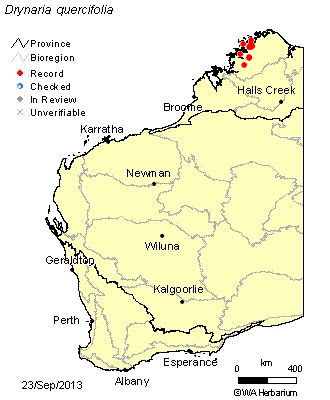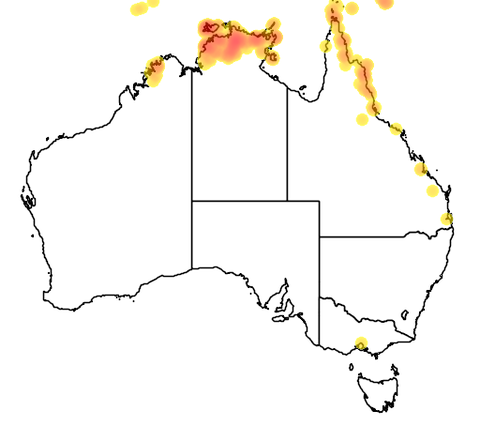Drynaria quercifolia or more commonly known as the Oak-leaf fern is a "basket fern" belonging to the Polypodiaceae family .The reason for its common name of "oak leaf" as the nest fronds resemble the leaves of Oaks. They are a terrestrial fern found among rocks in crevices,shelves or in the soil among boulders also epiphytic on tree trunks in open forests and rainforests. Drynaria quercifolia is native to western Australia as well as India, Southeast Asia, Malaysia, Indonesia, the Philippines and New Guinea. This species of fern is characterised imparticularly by having "wooly" rhizomes.
Not threatened
The Rhizomes are 2cm thick and wooly. The scales are a dark brown to ginger in colour and are 20-25mm long and 0.7-2.5mm wide and soft. Stipes are winged at the base and lamina are not separated into distinct leaflets.Sori are round and circular in shape. Spores 37.5-55um long,22.5-37.5um wide. Fronds are both fertile and sterile. The veins are prominent and easily visible (Flora base).
Drynaria quercifolia reproduces through spores, is not poisonous but is used frequently as a medicine in many cultures and has many medicinal purposes.
In 2010, twelve well-preserved fossil specimens of Drynaria were described from the Sanying Formation of the Yangjie coal mine of China. Named Drynaria callispora, it comes from the Piacenzian age of the Pliocene epoch (about 3.6 to 2.5 million years ago).[53]
The fossil record of Drynaria and drynarioids is not very well documented due to the typically poor preservation of fossils recovered. Previous fossil species assigned to Drynaria include Drynaria astrostigma, D. dura, and D. tumulosa from the Cenomanian of the Czech Republic; and D. durum, all assigned tentatively to the genus in 1899. The arrangement and type of their sori, however, indicate that they are members of the family Matoniaceae instead.[53]
Outside the genus, Protodrynaria takhtajani from the Eocene-Oligocene boundary of Kursk Oblast, Russia shows some affinities to Drynaria but only distantly. The only other reasonably convincing fossil remains of drynarioids aside from D. callispora was a specimen named Polypodium quercifolia recovered in 1985 from the Late Miocene (23.03 to 5.332 million years ago) of Palembang, Indonesia. These were later transferred to the living species Aglaomorpha heraclea. It remains, as of 2011, the oldest known drynarioid.[53][38]
Below is a reconstruction of the evolution of species of Drynaria and closely related genera Aglaomorpha and Selliguea based on combined morphological and molecular phylogenetic data (Janssen & Schneider, 2005). Drynaria is likely to be paraphyletic, in contrast to Aglaomorpha, another genus which possess specialized humus-collecting structures.[54]


in open forest, rainforest margins and in dry rainforest.
Drynaria quercifolia is benefitial to humans as it has many medicinal values. A recent experiment conducted shows that the bioactive compounds from the rhizome of Drynaria quercifolia can be used to screen the antibacteril activuty against infectious diseases causing bacetrial pathogens. Some of the diseases in which this fern will hopefully be bale to work against are Escherichia coli, Klebsiella pneumoniae and Proteus mirabilis, In many native tribes the various parts of the fern are used to cure various sicknesses and symptons. The plant is anthelmintic which helps expell worms and paraites from the body



Recent comments